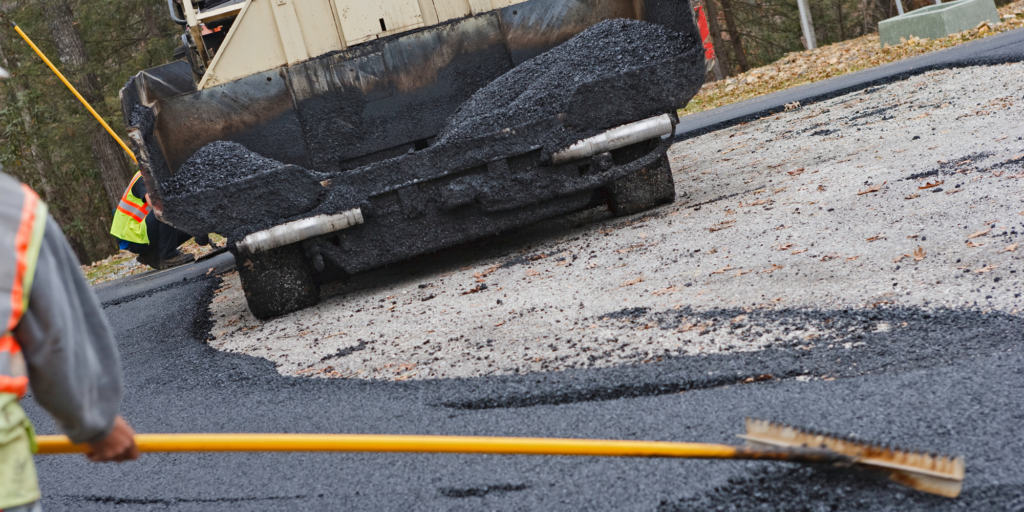Welcome to our asphalt paving temperature blog post! Understand how temperature affects asphalt quality, whether you’re a homeowner fixing your driveway or a contractor building a huge road. This article explains why temperature monitoring is crucial during asphalt paving and what can happen if it’s not.
What is asphalt?
In construction, asphalt (blacktop or bitumen) is versatile and widely utilized. Crushed stone and sand mixed with liquid asphalt cement make up most of it. This mixture generates a tough surface that can withstand traffic and weather.
Flexibility is a major benefit of asphalt. Asphalt can expand and compress without cracking under temperature fluctuations, unlike concrete. This makes it suitable for paving highways, parking lots, driveways, and other high-use surfaces.
Asphalt’s rough surface makes it durable and skid-resistant. This reduces rain- and snow-related road accidents.
The dark tone of asphalt absorbs sunlight, unlike lighter materials. Asphalt pavements mitigate urban heat islands by lowering ambient temperatures.
Flexible and durable asphalt reduces urban heat and provides safe driving surfaces. Its adaptability makes it suited for domestic and commercial use.
What is the temperature range for paving with asphalt?
The temperature matters while paving with asphalt. The recommended asphalt-laying temperature is 50°F to 85°F (10°C to 30°C). This window creates ideal pavement conditions for smoothness and durability.
Low temperatures below 50°F might cause hot mix asphalt to cool too quickly, making compaction difficult. A weaker pavement is more likely to break and deteriorate.
If temperatures exceed 85°F, hot mix asphalt might become overly soft. This makes compacting the material difficult, resulting in uneven surfaces and limited durability.
Maintaining an adequate temperature during paving keeps asphalt workable longer. It offers enough time for compaction without sacrificing quality.
Contractors may guarantee their paved surfaces are structurally solid and can endure heavy traffic by following these temperature guidelines. When dealing with asphalt, monitor temperatures!

Why is it important to keep track of the temperature when paving with asphalt?
Why does asphalt paving require temperature monitoring? Temperature is critical to asphalt pavement project performance and lifespan. Explore why.
The asphalt-paving temperature range is crucial. Asphalt must be laid at compaction and bonding temperatures. Too much cold will cause asphalt to not compact correctly, causing weak patches and cracks. However, too much heat can make asphalt unstable and hard to deal with.
Tracking temperatures helps project portions stay consistent. Temperature differences on a job site might affect compaction and quality. Contractors can guarantee uniformity during installation by regularly monitoring temperatures.
Paving without temperature monitoring can be disastrous. Due to poor layer bonding or density, improperly laid or cooled pavements are more likely to crack or rut.
Infrared thermometers and thermal imaging cameras can swiftly measure asphalt paving temperature.
What are the consequences of not keeping track of the temperature when paving with asphalt?
Asphalt paving without temperature monitoring might be dangerous. The asphalt may not adhere properly, creating a weak and unstable pavement surface. This can cause early cracking, potholes, and other damage.
Asphalt may cool too rapidly or slowly, reducing its quality and durability. If it cools too soon, its density may drop, weakening the pavement structure. However, delayed cooling might overcompact and distort under heavy traffic.
In addition to structural difficulties, temperature changes during paving can alter the finished pavement’s appearance. Poor temperature regulation can cause uneven paving of surface color and texture.
Lacking temperature monitoring while paving wastes time and costs. If harsh temperatures or weather conditions (such as freezing) make asphalt installation difficult, it will likely need to be redone at a higher expense.
Paving asphalt without monitoring temperatures might result in poor-quality pavements that deteriorate early and require costly repairs or replacement. Contractors and construction professionals must monitor asphalt paving temperatures throughout the process for long-term outcomes.
How can you keep track of the temperature when paving with asphalt?
Temperature is crucial while paving with asphalt. This makes the paving process smooth and produces a long-lasting surface. How can asphalt workers monitor the temperature?
Having accurate thermometers is essential. These instruments accurately measure air and asphalt mixture temperatures. You can keep these temperatures within an acceptable range for paving by testing them often.
In addition to thermometers, infrared cameras may monitor surface temperature. Real-time thermal imaging lets employees spot hot or cool asphalt patches with these cameras.
Remote sensors implanted in pavements are also effective. These sensors continuously track and report project site temperature changes.
Before paving, check weather forecasts. Understanding forthcoming weather might assist in evaluating if asphalt construction is appropriate or if adjustments are needed.
By using accurate thermometers, infrared cameras, remote sensors, and weather information, you can track asphalt temperatures and install pavement smoothly without sacrificing quality or durability!

Conclusion
Asphalt paving requires temperature monitoring for success and durability. Asphalt—a mixture of aggregates and a petroleum-based binder—performs best at certain temperatures.
The recommended asphalt paving temperature range is 50°F (10°C) to 90°F (32°C). Asphalt can be compacted properly within this range for adherence and durability.
Paving without temperature monitoring might have serious implications. If the asphalt is too cold, it may not bind or compact evenly, leaving weak patches that crack and deteriorate. However, hot pavement may become unstable and lose its ability to hold large loads.
Several ways you can track asphalt paving temperatures. For accurate surface temperature measurements, infrared thermometers or thermal imaging cameras are used. Before commencing a paving project, check weather forecasts because excessive temperatures can influence workability.

